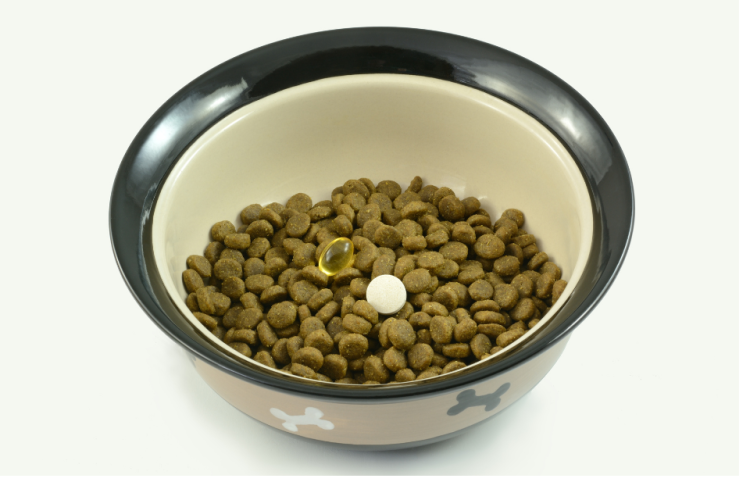Glucosamine is a naturally occurring compound that's one of the most popular ingredients used in over-the-counter (OTC) remedies for osteoarthritis in dogs. The organic compound is the building block for cartilage in both canines and humans, and new research finds it to be essential for preserving healthy joint function while minimizing joint pain.
If your pet has canine arthritis or osteoarthritis, you might have heard of this supplement before - but what exactly is it, how does it work, and how much glucosamine for dogs? We'll discuss all you need to know about the uses, dosage, and side effects of glucosamine for dogs.
- What is glucosamine for dogs?
- What does glucosamine do for dogs?
- Are there different types of glucosamine?
- What is the best glucosamine for dogs?
- How much glucosamine is safe for dog?
- What are the side effects of glucosamine in dogs?
- Is glucosamine safe for dogs with osteoarthritis?
- Key Takeaways
Pro Tip: Veterinarians often recommend glucosamine dietary supplements for dogs with joint conditions before prescription medications. If you have a pet insurance plan, you may be able to get reimbursed for a portion of these expenses, so long as they relate to a covered health condition.
What is glucosamine?
Glucosamine is an amino sugar that acts as the building block for collagen and is often used as a nutraceutical ingredient in joint supplements for dogs. Humans and animals naturally produce glucosamine in the body because the compound helps create molecules that form cartilage, or the spongy material that acts as a cushion between healthy joints.
Cartilage plays a significant role in the everyday functioning of the body, but when it becomes damaged over time, it doesn't have the ability to repair or duplicate itself on its own. Glucosamine is essential to repairing the naturally occurring wear and tear in joints, but the body produces less and less of the compound with age. As a result, bones in joint sockets may rub against each other, leading to friction, inflammation, pain, and conditions such as osteoarthritis.

History of Glucosamine for Dogs
Dr. Georg Ledderhose first identified glucosamine in 1876. He was a German surgeon who first detected human glucosamine while working on a cartilage study in school. However, it took until 1939 for Walter Haworth to define its stereochemistry – the spatial arrangement of atoms that form the structure of glucosamine’s molecules and their manipulation. Glucosamine and dogs have a long history dating back to the 1970s when it was first used as a treatment for animals. It’s since evolved from a shot injection to an oral tablet, meaning is much less invasive and easier to administer. \
Although there are only a few published studies that evaluate the effectiveness of glucosamine for dogs with joint issues, there’s a large volume of circumstantial evidence that suggests this compound may be incredibly helpful, as glucosamine - an amino sugar - seems to improve the synthesis of glycosaminoglycans, or GAGs, one of the primary building blocks of cartilage.
What does glucosamine do for dogs?
The top two benefits of glucosamine for dogs are the repaired cartilage damge and alleviation the symptoms of canine osteoarthritis. Additional glucosamine benefits include:
- Reducing inflammation and pain
- Restoring mobility and range of motion
- Decreasing stress placed on joints due to hip dysplasia or structural changes
- Assisting in the healing of spinal disc injury
- Soothing recovery from joint surgery
- Maintaining peak performance and healthy joints in younger dogs
Are there different types of glucosamine?
Before browsing joint supplements for dogs, there are several distinct types of the glucosamine you should know because each work slightly differently.
- Glucosamine sulfate is best and should be present in high-quality joint supplements. It’s extracted from shellfish and mussels, but it can also be produced synthetically. This type is considered the best glucosamine because it contains sulfur, which is vital to cartilage repair.
- Glucosamine hydrochloride is also extracted from shellfish and mussels. However, this type lacks sulfur, so glucosamine hydrochloride is usually less effective as a dietary supplement.
- N-acetyl-glucosamine is usually derived from glucose, which helps create the synovial fluid and hyaluronic acid that lubricates joints. This form is also common, but more often used for gut health rather than joint repair.
What is the best glucosamine for dogs?
Most glucosamine supplements for dogs come in the oral form of pills, tablets, chews, powders, and liquids. Dog joint supplements are widely available OTC in pet supply shops, veterinary offices, and online stores. In some cases, dogs may receive a glucosamine injection instead, but these must be administered by a veterinarian.
Glucosamine chondroitin supplements should be taken every day to effectively repair and stop the degenerative damage caused by osteoarthritis. If you miss a dose, proceed with the recommended amount the following day.
Keep in mind, many pet parents begin to give dogs glucosamine supplements early in life, around the age of two. This can help prevent joint-related issues down the road while promoting healthy exercise activity.

Glucosamine and Chondroitin for Dogs
When shopping for dog joint supplements, another ingredient to look for is chondroitin: a large polysaccharide (carbohydrate made up of sugar molecules) that’s often found in the body’s harder connective tissue, such as cartilage. Industry experts support the use of chondroitin sulfate for improving the symptoms, stopping, and possibly reversing the degenerative process of osteoarthritis.
Joint supplements often contain glucosamine and/or chondroitin for dogs due to the compound’s natural ability to:
- Promote water retention and elasticity
- Ensure appropriate shock absorption
- Nourish tissues in joint linings
- Prevent damage caused by inflammation
The organic ingredient is usually made from pig or cow cartilage, but it can also be synthesized from plant sources in a lab, or originate from shrimp, oysters, and crabs. Glucosamine chondroitin supplements are more effective as paired ingredients that complement each other, so look for joint supplements that contain both, if possible.
How much glucosamine for dogs is safe?
Vets often recommend a daily dose of about 20 milligrams of glucosamine for dogs, per each pound of body weight. If you’re unsure exactly how much your pet weighs, a general guideline for how many milligrams of glucosamine you should give dogs every day suggests:
| Dosage | Dog Weight |
|---|---|
| 250-500 mg | 5-20 lb |
| 500 mg | 20-45 lb |
| 1,000 mg | 45-90 lb |
| 1,500 mg | 90+ lb |
Treatments may start at a higher dose until you see signs of improvement, then gradually taper down in strength. Keep in mind, the correct amount will depend on your dog’s unique weight, age, and severity of the joint condition.
Note: If you’re unsure about how much glucosamine for dogs is correct in your pet’s specific healthcare plan, consult your vet. He or she is the best source of information regarding the proper administration of nutritional supplements because they’re familiar with your pet’s personal medical history and health condition.

What are the side effects of dog glucosamine?
Glucosamine in dogs has mild side effects, if any at all, because it’s a naturally occurring substance in the body. Possible side effects might include:
- Increased thirst
- Increased urination
- Trouble sleeping
- Occasional vomiting or diarrhea
These side effects are brief and should go away after several doses. However, once you begin the nutraceutical treatment, carefully observe your dog for any perceptible changes in behavior to confirm there is no allergic reaction after the first dose. If you notice something that might be serious, such as difficulty breathing, stop serving immediately and go to a local animal hospital.
Make notes about how your canine reacts to the glucosamine treatment, making sure to include the dates and dosage amount. This method can help you gauge how well they’re responding to the supplement and if there’s anything you need to make your doctor aware of.
Pro Tip: If your dog needs emergency treatment because of a bad allergic reaction, you should know that it often comes with a huge bill. That's where pet insurance proves its worth. With pet insurance, you can sleep tight knowing that you can efficiently deal with your pet's emergencies.
Is glucosamine safe for dogs with osteoarthritis?
Yes, glucosamine is safe for long-term use in pets who battle arthritic pain and other chronic joint diseases. The U.S. Food & Drug Administration does not review glucosamine and chondroitin as a drug, but rather a dietary supplement, so they are not subject to the same regulatory process. Nonetheless, they’ve been actively used in veterinary practices in the U.S. and Europe for more than 40 years.
Key Takeaways
- Dogs naturally produce glucosamine, a building block of cartilage, but it's also used as a nutraceutical ingredient in joint supplements for dogs.
- Vets often recommend glucosamine supplements to treat osteoarthritis in canines and alleviate pain caused by joint or bone conditions.
- You can improve your pet's joint health by purchasing glucosamine and chondroitin for dogs over-the-counter, but be sure to ask your vet for a recommended dosage beforehand.
- Because it's an organic compound, there are few side effects associated with glucosamine in dogs, but watch for allergic reactions that could occur.
